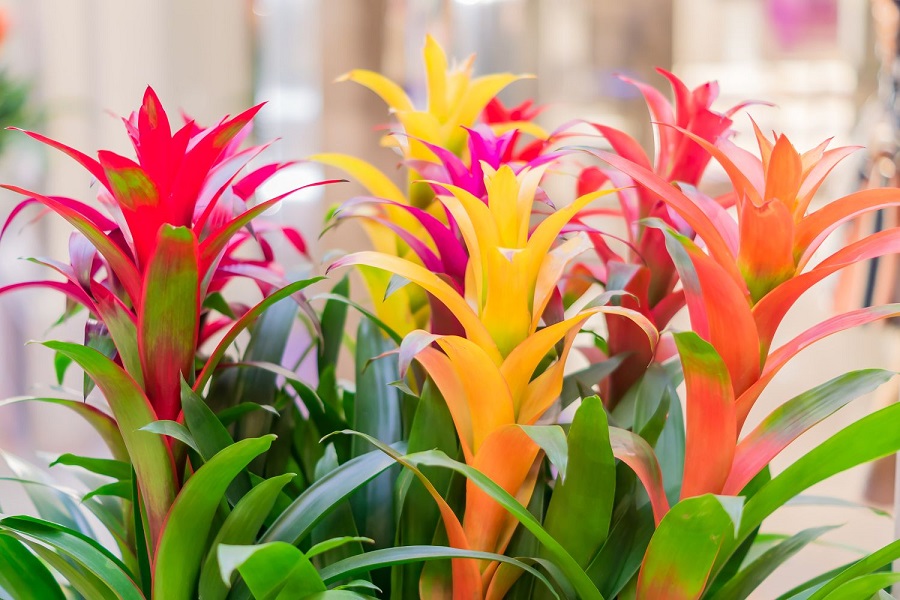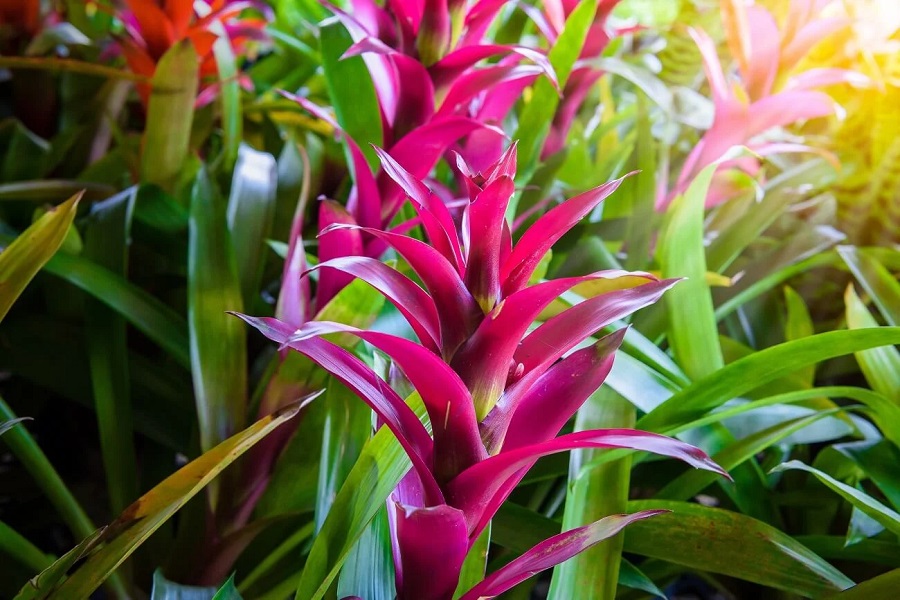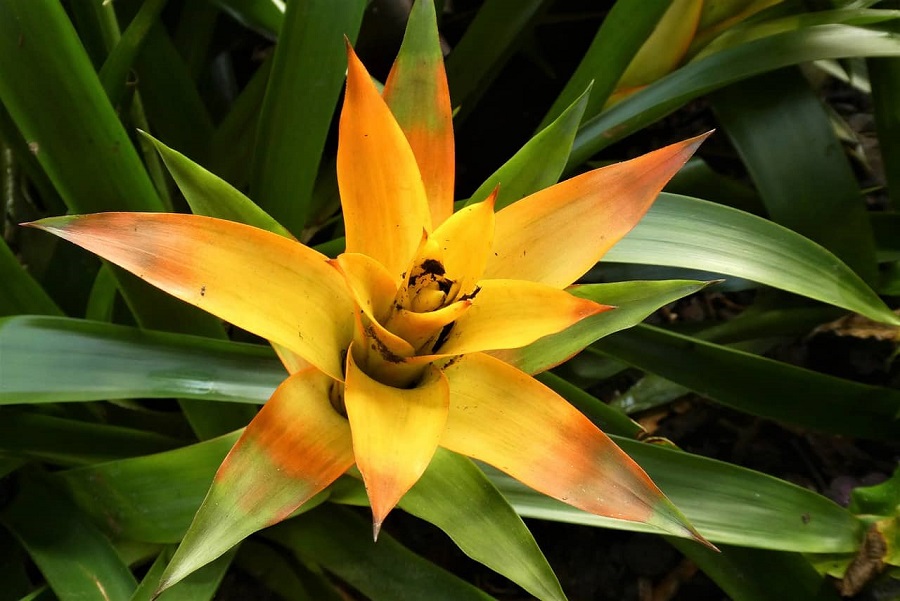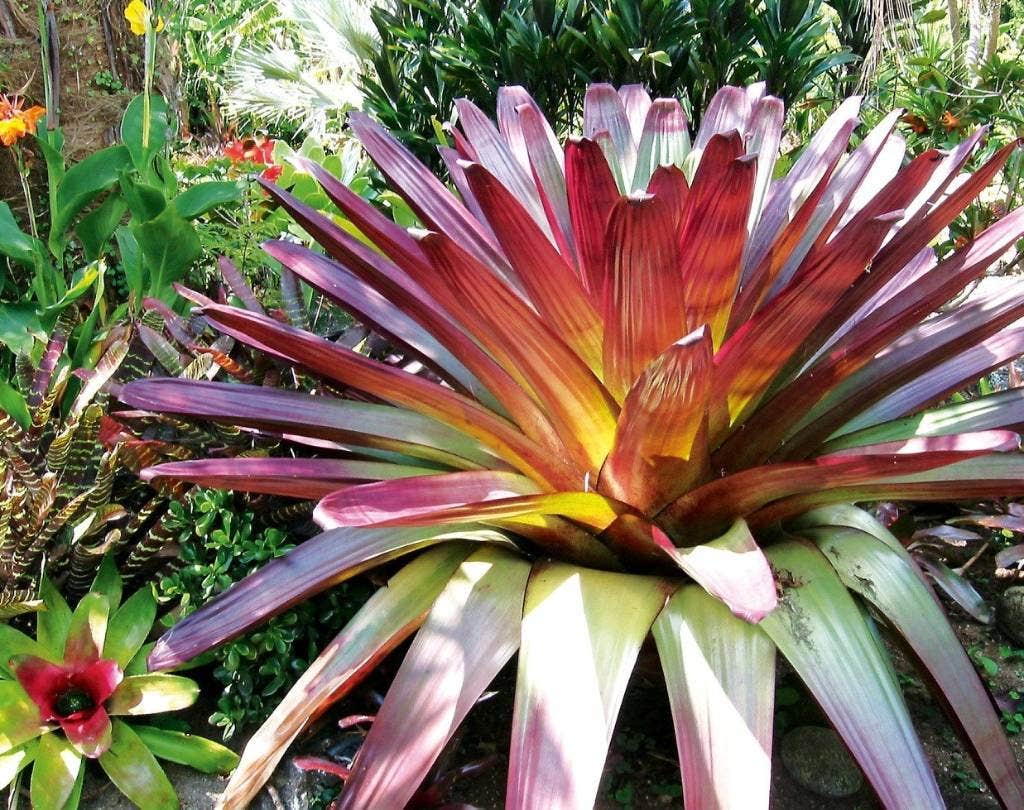Bromelias Exóticas - Cuidados, Tipos de Bromelias y Riego
La bromelia es una planta excepcionalmente fascinante de aspecto bastante exótico. Es una decoración habitual de los interiores de las casas. ¿Cómo se cuida esta inusual planta de interior? ¿Qué condiciones necesita? ¿De dónde procede? Descubra los secretos del cuidado de la bromelia y disfrute de su hermoso aspecto.

Bromelia: ¿qué tipo de planta es?
La bromelia también se conoce por su nombre científico Bromeliaceae. En su hábitat natural crecen unas 1600 variedades diferentes de esta planta. Se puede encontrar sobre todo en América del Norte y del Sur. Las bromelias crecen en distintas condiciones, dependiendo de la variedad. La mayoría aparecen en los árboles como epífitas, aunque también hay excepciones.

Tipos populares de bromelias
Las variedades de bromelias más populares son la Guzmania y la Vriesea. Ambas plantas de interior se comparan a menudo entre sí. En cuanto a la guzmania, su flor se asemeja a una fuente. La Vriesea forma una flor mucho más plana.
En ambos casos, las hojas de la planta son lisas y su color es verde intenso. También hay variedades con hojas multicolores. Lo más importante es que estas plantas tienen diferentes alturas y colores de sus flores.
Otros tipos populares de bromelias son:
- Aechmea,
- Tilandsia.
Aechmea es una de las variedades más antiguas. A diferencia de otras bromelias, tiene unas características hojas dentadas. La Aechmea Primera ha sido muy popular últimamente por su inflorescencia rosa. También hay variedades de flores blancas, rojas, naranjas y de doble color.
Tilandsia es otra variedad de bromelia que puedes cultivar fácilmente en casa. La pluma rosa es la planta más conocida de esta familia, también conocida como Tillandsia cyanea. Su penacho rosa con flores azules es la mayor ventaja de esta planta.

Bromelia - cuidados de la planta de interior
La bromelia en maceta es muy fácil de mantener. Muchos jardineros principiantes creen que sus coloridas hojas son flores. En realidad, estos elementos simplemente cambian su color de verde a medida que crecen. Las flores aparecen entre las hojas.
La posibilidad de florecer durante cualquier estación es la mayor ventaja de cultivar una bromelia en maceta. Este proceso depende sobre todo del desarrollo del penacho de la planta. Pero tenga en cuenta que la floración de la planta significa su inevitable final. Después de un periodo de floración relativamente largo, que dura de tres a seis meses, la planta muere y se seca. Los que se inician en la aventura de la jardinería no deben desanimarse: es algo completamente natural.

Bromelia - cuidados y riego
¿Se pregunta cómo se cuida una bromelia? Riegue la planta al menos una vez a la semana. Las hojas también requieren una nebulización bastante frecuente. Ten en cuenta el agua que utilizas. Debe ser blanda; si usas agua dura, es de esperar que queden feos residuos en la superficie de las hojas.
La clave para mantener la planta en las mejores condiciones es colocarla en el lugar adecuado. El lugar debe ser parcialmente soleado. También hay que tener en cuenta la temperatura adecuada. La planta se siente muy bien a 22-24°C (71,6-75,2°F).
Puedes colocar la bromelia en un balcón o patio en verano. Pero ten en cuenta que si las temperaturas bajan, tienes que cuidarla y trasladarla a casa o a un lugar más cálido. La temperatura no puede estar por debajo de los 20 °C (68 °F). Una temperatura más fría y un exceso de agua podrían causar problemas, incluida la putrefacción de las raíces.
Las bromelias pertenecen al grupo de plantas a las que no les gusta el aire seco, por lo que hay que evitar colocar la planta cerca de un radiador. La planta tampoco reacciona bien a las corrientes de aire. Asegúrate de protegerla también de este peligro.

Bromelia - floración
Cuando una bromelia empieza a florecer, es una señal para el propietario de la planta de que su vida está a punto de terminar. Tras un largo periodo de floración, la planta se seca y muere. Es un proceso natural que no se puede detener. Pero una vez que la planta se seca, se pueden recuperar las plántulas y volver a cultivarlas.
Bromelia - propagación
La propagación de la bromelia es el curso natural de los acontecimientos después de que termine de florecer. Cuando la planta muera, asegúrese de cortar las partes secas y observe el recipiente con cuidado. En lugar de la bromelia vieja, deberían aparecer nuevas “crías”. Si crecen lo suficiente, puedes ponerlas en nuevas macetas y volver a cuidar la planta.

Bromelia - plagas y peligros
La bromelia es una planta muy resistente que puede soportar condiciones cambiantes, excepto las bajas temperaturas. Sólo una planta debilitada o con las hojas dañadas puede convertirse en objetivo de las plagas. Por eso es tan importante cuidar el suelo fértil y manipular la planta con precaución.
En cuanto a las posibles plagas, no todos los bichos atacan a la planta. Los ácaros, las cochinillas y los trips son los más comunes. Si aparecen, asegúrate de utilizar un producto químico adecuado para deshacerte de los invitados no deseados. Si la infestación está en su fase inicial, también puedes probar algunos repelentes caseros. Los brebajes a base de ajo y cebolla son las soluciones más populares.

¿Cuáles son las enfermedades más comunes de las bromelias?
Las bromelias son plantas duraderas. Si alguna enfermedad las ataca, suele ser el resultado de un cuidado inadecuado de la planta. El problema más común es el pardeamiento de las hojas. Es un problema de las plantas sobrecalentadas que han estado expuestas a la luz solar intensa durante mucho tiempo.
A veces, el sistema radicular de la planta puede pudrirse. Esto ocurre como resultado de un exceso de riego de la planta.

📍 ¿Cuánto tiempo florecen las bromelias?
Las flores de las bromelias están consideradas como una de las más bellas de todas las plantas de interior. Hay que tener en cuenta que la planta sólo florece una vez en toda su vida, al igual que el agave. Dependiendo de las condiciones proporcionadas a la planta, puede florecer de tres a seis meses.
📍 ¿Cómo regar la bromelia?
Las hojas de las bromelias tienen pelos y puntas especiales: la planta los utiliza para recuperar el agua y otros nutrientes necesarios. Riegue la tierra sólo ligeramente, normalmente una vez a la semana. Si la planta está floreciendo, puedes rociarla con agua de vez en cuando.
📍 ¿Cuál es el mejor suelo para una bromelia?
Cultivar una bromelia es relativamente sencillo, pero la planta necesita una buena tierra. Puedes utilizar mezclas compradas en la tienda para plantas de interior y, además, mezclarlas con arena. Asegúrate de tener una capa de drenaje en el fondo, para que la tierra sea permeable.
📍 ¿Qué hacer con la bromelia después de la floración?
¿Se pregunta qué hacer cuando su bromelia termine de florecer? La propagación es el siguiente paso natural. En primer lugar, retira los tallos marrones de la planta. Si la bromelia ha crecido en buenas condiciones, es probable que haya desarrollado nuevas crías. Éstas se convertirán en nuevas plantas.
Artículos destacados




